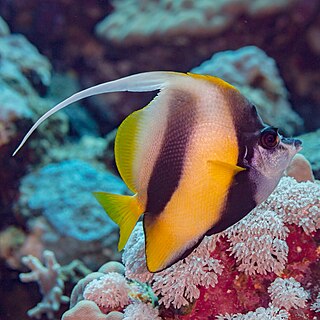
The emperor angelfish is a species of marine angelfish. It is a reef-associated fish, native to the Indian and Pacific Oceans, from the Red Sea to Hawaii and the Austral Islands. This species is generally associated with stable populations and faces no major threats of extinction. It is a favorite of photographers, artists, and aquarists because of its unique, brilliant pattern of coloration.

Platycephalus is a genus of mostly marine, demersal ray-finned fish belonging to the family Platycephalidae. They are found in the eastern Mediterranean, the Indian Ocean and western Pacific Ocean.

The Red Sea bannerfish is a species of marine ray-finned fish, a butterflyfish from the family Chaetodontidae. It is found in the western Indian Ocean. It has been recorded as an introduced species off Florida and as a Lessepsian migrant in the eastern Mediterranean Sea off Turkey.

The tentacled flathead, also known as the Indian Ocean crocodilefish, Madagascar flathead or longhead flathead, is a species of marine ray-finned fish belonging to the family Platycephalidae, the flatheads. This species is in the western Indian Ocean, including the Red Sea and the Mediterranean, having invaded as a Lessepsian migrant through the Suez Canal. It is the only species in the monotypic genus Papilloculiceps.

Platax teira, also known as the teira batfish, longfin batfish, longfin spadefish, or round faced batfish is a species of marine ray-finned fish belonging to the family Ephippidae, the spadefishes and batfishes. This species is found in the Indo-West Pacific.

The streaked spinefoot, also known as the Java rabbitfish, blue-spotted spinefoot, blue-spotted trevally, Java spinefoot or white-spotted rabbit-fish, is a species of marine ray-finned fish, a rabbitfish belonging to the family Siganidae. It is found throughout most of the Indo-Pacific region.

Pagellus bellottii, the red pandora, is a species of marine ray-finned fish belonging to the family Sparidae, the sea breams and porgies. This species is found in the eastern Atlantic Ocean and the Mediterranean Sea.

Scorpaena scrofa, the red scorpionfish, bigscale scorpionfish, large-scaled scorpion fish, or rascasse is a venomous marine species of ray-finned fish in the family Scorpaenidae, the scorpionfishes. It is found in the Mediterranean Sea, in the eastern Atlantic Ocean and the western Indian Ocean.

Carl Benjamin Klunzinger was a German physician and zoologist.

Caesio is a genus of marine ray-finned fish, fusiliers belonging to the family Lutjanidae. They are native to the Indian Ocean and the western Pacific Ocean, although one species has invaded the eastern Mediterranean Sea through the Suez Canal by Lessepsian migration.

The dusky spinefoot, also known as the squaretail rabbitfish, is a species of marine ray-finned fish, a rabbitfish belonging to the family Siganidae. It is native to the western Indian Ocean which has spread to the Mediterranean Sea through the Suez Canal. Its fin spines contain venom. It is regarded as a food fish.

Lutjanus fulviflamma, the dory snapper, blackspot snapper, black-spot sea perch, finger-mark bream, long-spot snapper, Moses perch or red bream, is a species of marine ray-finned fish belonging to the family Lutjanidae, the snappers. It has a wide Indo-Pacific distribution.

Sphyraena chrysotaenia, the yellowstripe barracuda, is a species of predatory, ray finned fish from the family Sphyraenidae which is found in the Indo-West Pacific region. It has entered the Mediterranean Sea from the Red Sea through the Suez Canal as a Lessepesian migrant and is now an important species in the fisheries of the eastern Mediterranean.

Jaydia smithi, Smith's cardinalfish, is a species of ray-finned fish from the Indian and Pacific Oceans, a member of the family Apogonidae. It has colonised the eastern Mediterranean Sea by way of the Suez Canal since 2007.

Siganus rivulatus, the marbled spinefoot, rivulated rabbitfish or surf parrotfish, is a gregarious, largely herbivorous ray-finned fish of the family Siganidae. Its natural range encompasses the western Indian Ocean and the Red Sea from where it colonised the Mediterranean Sea by Lessepsian migration through the Suez Canal. It is the type species of the genus Siganus.
Oxyurichthys petersii, commonly known as Peters' goby, is a species of ray-finned fish, a goby, from the family Oxudercidae. It is native to the Red Sea, and has now colonised the eastern Mediterranean Sea by Lessepsian migration through the Suez Canal.

Upeneus pori is a species of marine ray-finned fish, a goatfish from the family Mullidae which is found in western Indian Ocean and the eastern Mediterranean Sea.
Epinephelus geoffroyi, the Red Sea spotted grouper, is a species of marine fish in the genus Epinephelus in the grouper family. The species was first described in 1870. E. geoffroyi was previously considered a synonym of Epinephelus chlorostigma, but Randall et al. recognized it as a valid species in 2013.

Equulites popei, Pope's ponyfish, is a species of marine ray-finned fish, a ponyfish from the family Leiognathidae. It has a wide Indo-Pacific distribution which extends from the Red Sea east to the western Pacific Ocean. It has entered the Mediterranean as a Lessepsian migrant. It was formerly considered to be synonymous with the elongate ponyfish.

The rubberlip grunt is a species of marine ray-finned fish, a sweetlips belonging to the subfamily Plectorhinchinae, one of two subfamilies in the family Haemulidae, the grunts. It is native to the eastern Atlantic Ocean.

















